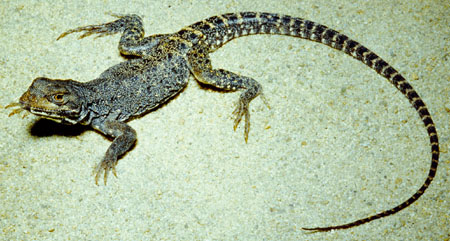|
| Query: Small white | Result: 1215th of 2237 | |
Baja California Leopard Lizard (Gambelia copei) - Wiki
| Subject: | Baja California Leopard Lizard (Gambelia copei) - Wiki
| |

| Resolution: 450x241
File Size: 56404 Bytes
Upload Date: 2007:09:19 17:13:31
|
Baja California leopard lizard
From Wikipedia, the free encyclopedia
[Photo] Gambelia copei. Source: USGS, http://www.werc.usgs.gov/fieldguide/gaco.htm Photo by John Tashjian. License: public domain
The Baja California leopard lizard (Gambelia copei) is a species of lizard. It is between 8 and 14 cm long, and has a smoky grey color and darker grey or black dorsal spots, edged in lighter shade. The dorsal pattern appears mottled or occelated. There are light crossbars on the dorsum, and light grey or white on the venter. It has small granular scales. The large head is distinct from neck, and the lining of mouth and throat are purplish-black. Juvenile lizards are similar to adults, but have a more distinct banding across dorsum. Females develop red-orange blotches on their ventral side during breeding season. Males have femoral pores.
The Baja California leopard lizard is an uncommon species. They are powerful bipedal runners. Adults can inflict a painful bite. They prefers chaparral habitats with an open understory.
http://en.wikipedia.org/wiki/Baja_California_leopard_lizard
| The text in this page is based on the copyrighted Wikipedia article shown in above URL. It is used under the GNU Free Documentation License. You may redistribute it, verbatim or modified, providing that you comply with the terms of the GFDL. |
|
^o^
Animal Pictures Archive for smart phones
^o^
|
|